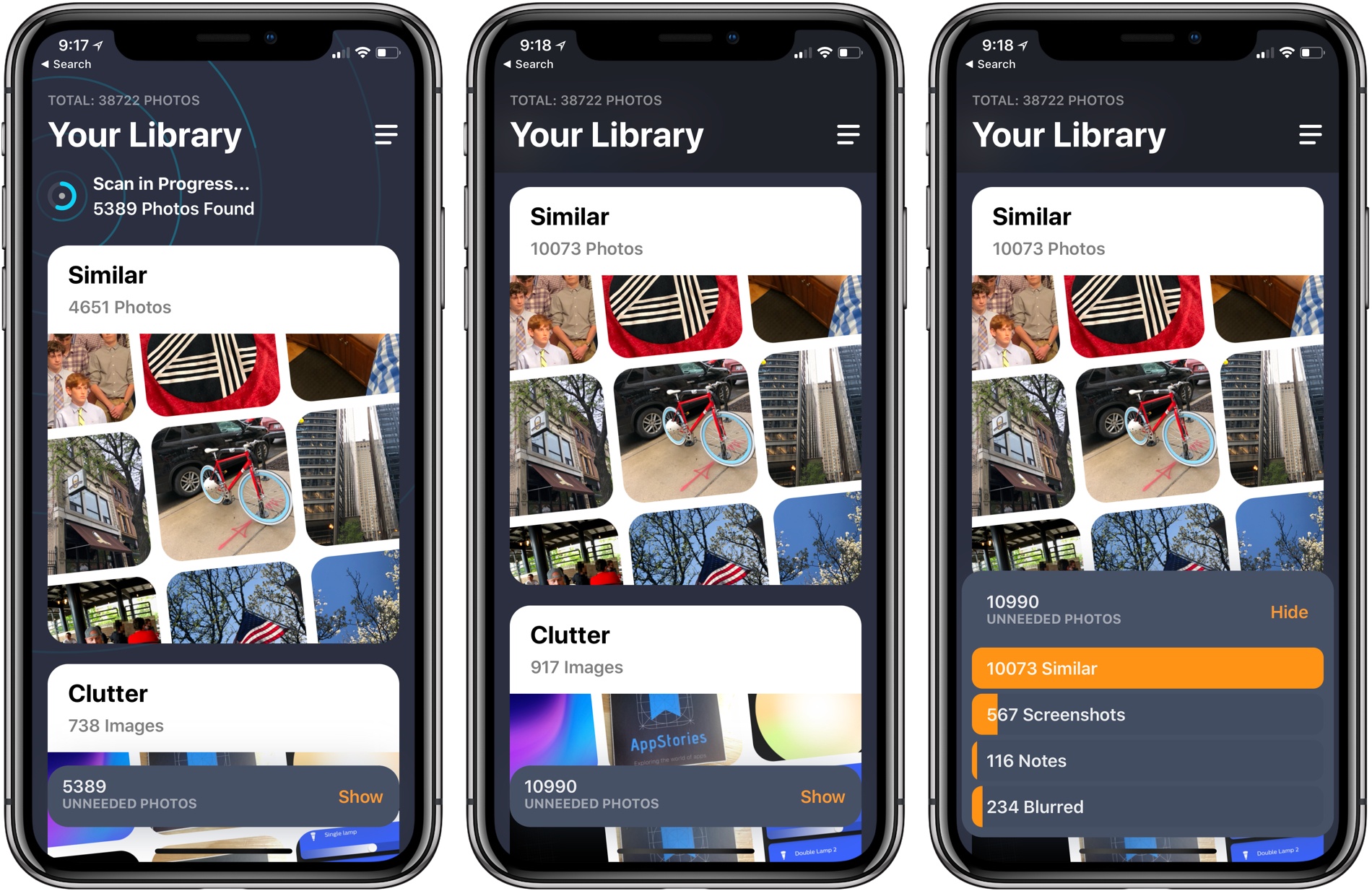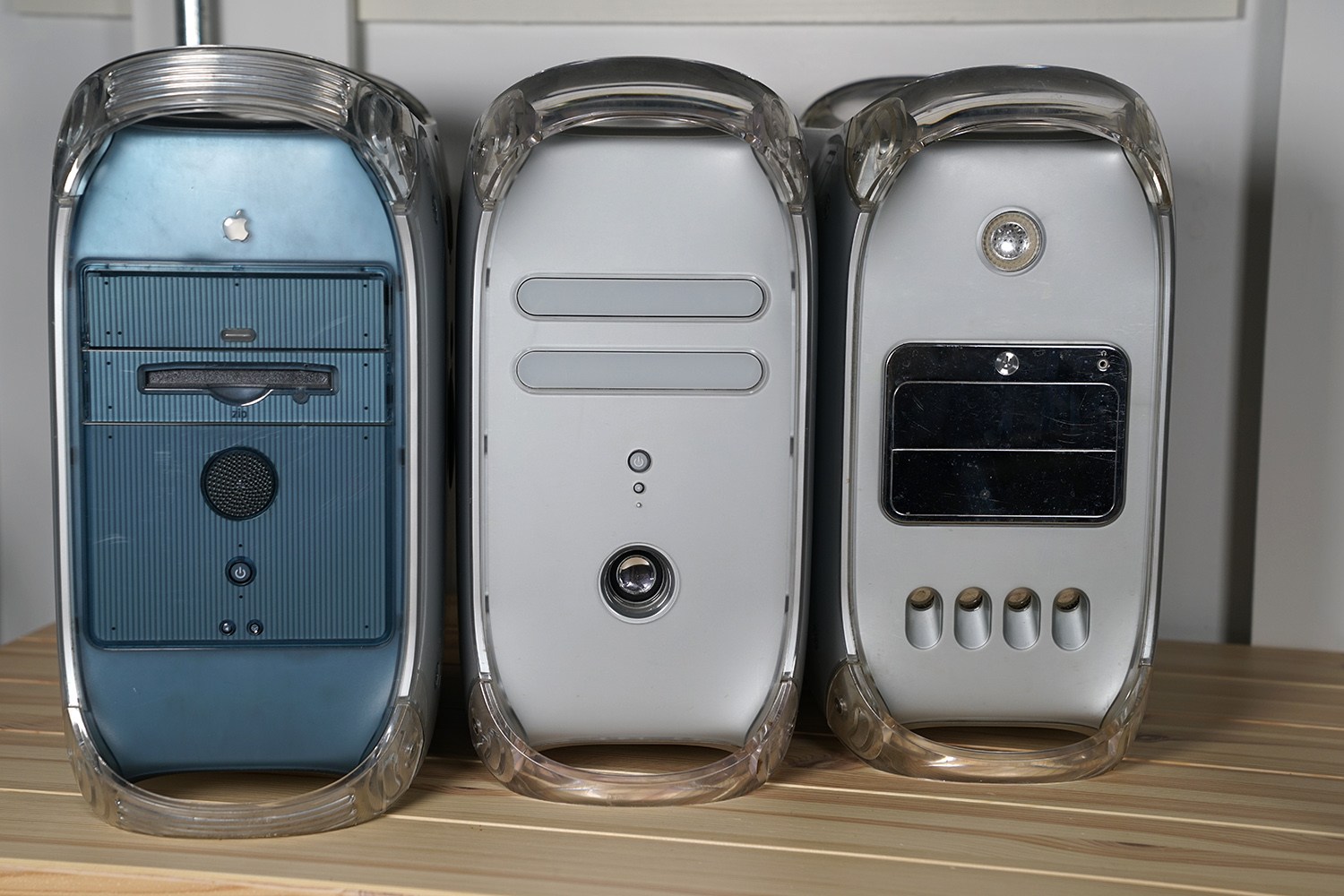MacPaw has released a brand new iPhone app that takes the ideas from Gemini 2, the company’s duplicate file finder on the Mac, and applies them to your iOS photo library. Gemini Photos uses an algorithm to analyze your photos that suggests the ones you should consider deleting. With photo files getting bigger with each improvement of the iPhone’s camera and features like Live Photos and burst mode, a utility like Gemini Photos can save significant amounts of space on your iPhone.
Gemini Photos Declutters Your Photo Library
The Power Mac G4 Line
The tower form factor may be a thing of the past, at least until the new Mac Pro shows up next year, but for years, if you needed the most powerful and flexible machine money could buy, the Power Mac was the only way to go.
For almost five years, the heart of the Power Mac was the PowerPC G4 chip. Starting in 1999 it clocked at just 350 MHz, but by the time the Power Mac G4 line was retired, a tower with dual 1.42 GHz CPUs could be ordered. In that time frame, things like Gigabit Ethernet, SuperDrives, and Wi-Fi became mainstream.
The Power Mac G4 came in three distinct cases over the years it was available. Each style of machine saw several revisions while in service, bringing the total number of models to 10. That’s a lot of computers to cover, so let’s get started.
Castro 3 Review: The Castro You’ve Always Wanted
Castro has long been one of the premier podcast clients on iOS, and its excellent version 2 – with an innovative triage system and delight-inducing design touches – helped solidify it as such. Those strengths in 2.0, however, were mitigated in part by the absence of a few key features that competing podcast apps tout. That changes with Castro 3.
If you’re unfamiliar with the app, Castro’s centerpiece feature is a triage system involving an inbox and queue. The premise is that, with the rising popularity of podcasting, there are more great podcasts available than ever before. If you subscribe to lots of shows, the standard episode management tools found in competing apps likely aren’t sufficient. With Castro, by default new episodes of shows land in your inbox, and can then be sorted to the top or bottom of your queue and downloaded, or archived if they’re not of interest to you. It’s an elegant solution to the problem of podcast overload, and, thanks to customization options that allow you to make certain shows populate the top or bottom of the queue automatically, it’s a system that works for you, tailored to your listening preferences.
Castro’s triage system clicked with me the first time I tried it, and I used the app daily for nearly a year. Eventually though, I became more selective about the portions of podcasts I listened to, and Castro’s lack of chapter support sent me elsewhere. I’ve seen comments from other prospective Castro users who were similarly turned off from the app due to one missing feature – and often, this feature was different for different people.
If an absent feature ever kept you from sticking with Castro 2, that almost certainly won’t be a problem anymore. Castro 3 addresses nearly all of those “one missing feature” requests in a single release. Trim Silence is Castro’s take on Overcast’s Smart Speed; full chapter support is now present, as is a new Apple Watch app; the player screen has been fully redesigned; Mix to Mono improves stereo mixes that are hard to hear; and finally, there are excellent new per-podcast controls in a variety of areas. Perhaps the only thing still missing is an iPad app.
Castro 3 is everything Castro already was, but better. It’s the app that Castro fans have always wanted.
Regain Control of Your Inbox with SaneBox’s Customizable Tools [Sponsor]
At its core, SaneBox is about making sure that only your most important messages hit your inbox. Other messages are safely stored in automated folders like the @SaneLater, @SaneBulk, and @SaneNews folders for reviewing later.
But email sorting is just the tip of the iceberg. With custom folders, custom snooze settings, and @SaneReminders, SaneBox takes email management to the next level.
Set up a custom folder and train it by dragging in a few messages. SaneBox will send all messages from the senders to your new folder. It’s a painless way to organize messages for a special project.
SaneSnooze folders can be customized to defer messages anywhere from hours to weeks. SaneBox comes with default snooze folders like @SaneTommorrow and @SaneNextWeek, but adding custom snooze folders lets you set when messages reappear in your inbox with precision.
SaneReminders are a great way to keep on top of tasks. Send yourself a reminder to do something later or get a reminder that someone hasn’t responded to a messages. For example, blind copy [email protected] and the message will show up back in your inbox only if the recipient doesn’t reply within 3 days.
Also, don’t forget that SaneBox works on top of your existing email setup. There’s no app to download or new email account to set up. You can use any email client you want.
Sign up today for a free 14-day SaneBox trial to take back control of your email. MacStories readers can receive a special $25 credit automatically by using this link to sign up.
Our thanks to SaneBox for sponsoring MacStories this week.
Google Introduces YouTube Premium and YouTube Music Subscription Services, Retires YouTube Red Moniker
Google seems to have an affinity for constantly rebranding its products, and today is the latest example of that. Soon, YouTube Red will be replaced by the more costly $11.99/month YouTube Premium service – the good news is that Premium members will get all the benefits of YouTube’s new Music service thrown in too. And if you’re an existing Red subscriber, or sign up quickly before Premium launches, you can lock in the existing $9.99 monthly rate and still get all the benefits of Premium and Music.
YouTube Music is Google’s attempt at taking on streaming services like Apple Music and Spotify directly. Launching May 22nd, YouTube Music will have both a free tier and a paid, $9.99/month option. The main focus here is the paid plan though, as it will be the only way to enable background listening – a pretty important feature for music. Paid subscribers will also benefit from downloads and ad-free listening.
YouTube Music will launch with a new mobile app and desktop player, and use Google’s intelligence to power advanced search capabilities and an aggregation of different song versions you may not find elsewhere. In a confusing move, Google Play Music will continue to exist as a separate service from YouTube Music, but if you’re a subscriber to the former, you get the latter service at no extra cost.
As someone who uses YouTube regularly, but not enough to justify a Red subscription, the new Premium plan definitely seems like a more attractive all-around product, despite the price hike: you get a full-fledged music streaming service, YouTube Originals, and a better viewing experience on the largest video source in the world thanks to downloads, no ads, and background playback, all for $11.99. Spotify and Apple Music subscribers may be content with their chosen services for now, but if YouTube Music truly does become a legitimate contender in the streaming market, it will be hard to resist the allure of YouTube Premium for all the extra perks it offers.
At launch, YouTube Music and Premium will be available in the United States, Australia, New Zealand, and Mexico, and they’ll arrive shortly thereafter in Austria, Canada, Denmark, Finland, France, Germany, Ireland, Italy, Norway, Russia, Spain, Sweden, Switzerland, and the United Kingdom.
Connected, Episode 193: They Belong to the World Now→
The future of third-party Twitter apps looks grim, but is it the end of the road? What makes an upgrade worthy of a price tag? Do class action lawsuits even matter? Should you use AirPods on planes? Does anyone like show descriptions written as hypothetical questions?
On this week’s episode of Connected, we talk about changes coming to third-party Twitter clients, the economics of the App Store when it comes to selling new versions of apps as separate purchases, and why you really shouldn’t use AirPods on planes. You can listen here.
Sponsored by:
- Linode: High performance SSD Linux servers for all of your infrastructure needs. Get a $20 credit with promo code ‘connected2018’
- Skillshare: Thousands of classes to help you do your best work. Get 2 months of unlimited access to over 20,000 classes for $0.99.
- Layers: A conference about design and technology. June 4-6, 2018 - San Jose, CA. Get $50 off with the code ‘relay’.
Apple Updates Its Website for Global Accessibility Awareness Day
Apple has updated its homepage and accessibility webpage to celebrate Global Accessibility Awareness Day. The event, which Apple has marked in a variety of ways over the years, was created to promote access to technology and foster inclusion for people with disabilities.
Apple’s homepage includes a banner image highlighting the accessibility features of its products with the statement ‘Technology is most powerful when it empowers everyone.’ The Accessibility section elaborates on that idea with a video first published in 2016 and the following:
Taking a family portrait. Catching up over FaceTime. Raising the blinds to let in the morning light. We want everyone to enjoy the everyday moments that technology helps make possible, so we work to make every Apple product accessible from the very start. Because the true value of a device isn’t measured by how powerful it is, but by how much it empowers you.
The remainder of the Accessibility page is organized into sections dedicated to vision, hearing, physical and motor skills, and learning and literacy that outline accessibility features of Apple’s products and demonstrates them with animations and videos.
The updates to Apple’s website and its announcement that it is working with schools for blind and deaf students to help teach them to code is a reminder of the importance of accessibility to the company that hopefully encourages third-party developers to make accessibility a priority too.
Apple Announces ‘Everyone Can Code’ Partnership with Schools for Blind and Deaf Students→
In March, Apple lead a Swift Playgrounds course at the Texas School for the Blind and Visually Impaired. Today, which is Global Accessibility Awareness Day, Apple announced that is partnering with schools in California, Texas, New York, Florida, Illinois, and Massachusetts:
Beginning this fall, schools supporting students with vision, hearing or other assistive needs will start teaching the Everyone Can Code curricula for Swift, Apple’s powerful and intuitive programming language.
Tim Cook, Apple’s CEO, said:
“Apple’s mission is to make products as accessible as possible,” said Tim Cook, Apple’s CEO. “We created Everyone Can Code because we believe all students deserve an opportunity to learn the language of technology. We hope to bring Everyone Can Code to even more schools around the world serving students with disabilities.”
In addition to existing iOS accessibility features, Apple is augmenting the Everyone Can Code curricula with tools and resources targeted at students with visual and hearing impairments.
Twitter Announces New End-of-Life Date for APIs and Pricing That Affects Third-Party Apps
In April, Twitter delayed a transition to a new API that was expected to have a significant impact on third-party Twitter clients like Twitterrific and Tweetbot. The delay came in the wake of an outcry from users of third-party Twitter clients prompted by developers who banded together to encourage users to complain to Twitter about the API changes that were set to take effect on June 19, 2018. Today, Twitter announced that those changes would go forward on August 16, 2018 – about two months later than originally planned.
Yesterday, in an interview with Sarah Perez of TechCruch, Paul Haddad of Tapbots, the maker Tweetbot, said:
“Twitter has a replacement API that – if we’re given access to – we’ll be able to use to replace almost all of the functionality that they are deprecating,” he explains. “On Mac, the worst case scenario is that we won’t be able to show notifications for Likes and Retweets. Notifications for Tweets, Mentions, Quotes, DMs and Follows will be delayed one to two minutes,” Haddad adds.
He also says that Tweets wouldn’t stream in as they get posted, but instead would come in one to two minutes later as the app would automatically poll for them. (This is the same as how the iOS app works now when connected to LTE – it uses the polling API.)
In addition to announcing transition date, Twitter announced pricing for its new API, and it’s expensive. A subscription covering 100-250 users will cost $2899/month, which works out to over $11 per user for 250 users. Anyone with over 250 users, which would include all the major third-party Twitter clients, is advised to contact Twitter for enterprise pricing. However, the pricing on the API’s lower tiers doesn’t leave much room for optimism.
Third-party clients that can’t or don’t want to pay those prices will have to make do without timeline streaming and push notifications for likes and retweets. Other notifications will be delayed approximately 1-2 minutes according to statements by Haddad to TechCrunch.
For its part, Twitter has made it clear, that the functionality of the old APIs will not be coming to the new APIs:
“As a few developers have noticed, there’s no streaming connection capability or home timeline data, which are only used by a small amount of developers (roughly 1% of monthly active apps),” writes Twitter Senior Product Manager, Kyle Weiss, in a blog post. “As we retire aging APIs, we have no plans to add these capabilities to Account Activity API or create a new streaming service for related use cases.”
We contacted The Iconfactory, the maker of Twitterrific, and Tapbots,1 the maker of Tweetbot, to ask about the impact of the API changes on third-party clients and Twitter users. According to Iconfactory developer Craig Hockenberry:
A lot of functionality that users of third-party apps took for granted is going away. That was the motivation for the apps-of-a-feather.com website - to soften the blow of this announcement.
Hockenberry elaborated that The Iconfactory has reached out to Twitter regarding enterprise pricing for the new APIs, but says that he doesn’t anticipate the pricing will be affordable absent a significant discount.
On the one hand, this latest blow to third-party Twitter clients may be something that some users, including me, are willing to tolerate. On the other hand, this is yet another example of third-party client hostility demonstrated by Twitter stretching back at least five years that doesn’t bode well for the long-term viability of those apps. I asked Hockenberry what he thinks the changes mean to third-party Twitter apps. His response:
Long term, I don’t think there will be any apps other than the official one. I also don’t think Twitter realizes that many long-time users, who are highly engaged on the service, are also the people who use third-party apps. These folks will look elsewhere for their social media needs.
Given Twitter’s repeated hostility towards third-party clients, that’s a hard sentiment to argue against and one that gets my attention more than Twitter’s announcement. I can live with the latest changes to Twitter’s API, but if third-party developers conclude that their time and resources are better spent elsewhere, I expect the end of the Twitter I know and use today is closer than I thought.
- As of publication of this post, Tapbots has not responded to our inquiry. ↩︎









